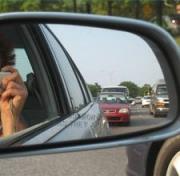A reader sent me this Autoblog link which says that accidents involving the blind-spot are on the rise.

The article says that the number of crashes involving lane changing on motorways is increasing – up a half over the last two years. It calls this kind of incident (not just on motorways, I assume) a “blind-spot accident”.
The organisation which did the research says that most accidents occur when moving from the right to the left (e.g. cutting in after overtaking).
I suppose my immediate response has to be why this is such a surprise? The way people drive is hardly conducive to not having accidents. In fact, something which is increasingly getting on my nerves when I’m out on lessons is when the car just behind you on the dual carriageway is doing 2mph over the speed limit to get past you, and then cuts into the perfect gap your pupil has left between themselves and the car in front. It’s got to the point where I say to mine “just watch this. He’s going to cut in”. And they do.
Before I go any further, let me just offer some quotations from a forum frequented by learners. These are from a topic called “Stupid things taught for the test”, and all spelling is as it appears in the forum:
[the first reply]…you definitely do not need to check you main mirror as much as they tell you to…
…The ridiculous usage of the parking brake. I mean who the **** uses a parking brake when you are doing a 3-point turn….
… Also, parallel parking can be avoided in everyday life, and you don’t to mirror check every 3 seconds…
…Push/Pull steering….
…Overuse of the handbrake. Useful if you are in a manual car on a hill, but you don’t need to apply it as often as you are told…
…Stall routine. No need to go the long way about it like you do as a learner….
…dont indicate round parked cars, dont turn the wheel when stationary [i.e. you SHOULD do these things]…
…I didn’t use my handbrake once on my test apart from parking right at the end… is it usually necessary in a test..? My instructor said technically I should but never really enforced it…
…The hazard perception test…
…I never use my handbrake, even on a hill… I never put the car in neutral… I never do that stupid awkward steering thing where you pass the wheel from hand to hand… That’s downright dangerous… I rarely drive with two hands on the wheel… I frequently go 5th -> 2nd.
…slowing down for the corner about 4 years in advance…
…All you have to do is pass the test. After that you’re chilling…
…I never use any of my external mirrors in my car, but that’s because all three are useless except for one of the offside ones – which is brilliant for pulling out onto the road from a parallel park. Interior mirror is wonderfully useful, but that’s about it, so I tend to turn my head to look instead if it’s anything I can’t see out of my rear windscreen…
…My car cruises at at 50mph on the motorway, I won’t be overtaking anybody. For other lane changes like roundabouts and junctions, I get by perfectly well (and have done for a year with no near misses or anything like that) by turning my head… I can see perfectly well what’s going on behind me through my rear view mirror…
…Oh and as other people have said, checking your mirror, you don’t need to do it as much in ‘real life’ but it’s good to get into the habit for the test…
Is it any wonder that driving standards are so poor out there? These are mostly recently passed drivers (with a few know-it-all petrol heads with relatively vast experience covering a few months or years). It’s also worrying some of the crap some of them have apparently been taught, such as check the mirrors every 3 or 5 seconds – that’s bound to give the wrong message, isn’t it?
This is just one discussion thread, but there are many others. They just don’t think mirrors or other safety-related skills are important.
The Autoblog article mentions the usual mitigating circumstances designed to deflect blame from its obvious target – cars are safer, door pillars bigger, the EU, etc. That’s bollocks.
It’s down to one thing, and one thing only: crap driving.
As an aside (well, it is related), a few months ago one of my pupils failed her test. She’s since passed, but this failure was for one thing only. She’s come to a give way line on an angled road, with traffic coming only from the left. The problem was, she’s turned the steering wheel so much that her angle was even more acute than usual, and as a result she couldn’t see traffic coming from the right for the examiner, the passenger seat, the door pillar, and so on.
How did she deal with it? She decided to just go and hope for the best.
The examiner quite rightly didn’t share her opinion and used the duals (there was someone coming), and yet to this day she maintains that it was the only thing she could have done, and that the examiner was being an arse. We had some major arguments about it in her subsequent lessons – there was no way I was going to give her an inch on such a stupid outlook. She couldn’t (and still cannot) see how she shouldn’t have got herself in that position to start with, and having done so should have asked the examiner to move his head or something until she could see.
Most worryingly, her reason for learning to drive was to be able to drive her kids to and from school.

I see the same behaviour daily. Just today on a lesson, my pupil was going ahead at a roundabout in the left lane (near Morrissons in Netherfield) then to turn left at the lights 50m further on. A woman in a silver Mercedes A160 (reg. no. FG61 CCN) got in the right lane and cut in to the left one the roundabout in front of us. It was deliberate and calculated. Even worse, she had a Baby on Board sticker in the back, so presumably her brat was in there with her. She knew she’d done it, because after she’d successfully read my lips she then spent the next 30 seconds trying to avoid making eye contact. Mind you, the fact that she used this time to peel a banana, and then break the 40mph speed limit on the Colwick Loop Road may also have had something to do with it.
It is genuinely frightening. She is typical.









